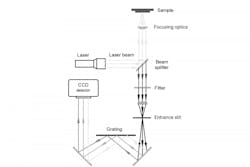Applications of Raman Spectroscopy
Applications of Raman Spectroscopy
Raman spectroscopy is a powerful analytical technique that provides insights into the molecular composition and structure of materials. Raman spectroscopy relies on the interaction between photons and molecular vibrations. When a sample is exposed to monochromatic light, most photons undergo elastic scattering, where their energy remains unchanged. However, a small fraction of photons interacts with the sample’s molecules and undergoes inelastic scattering, known as Raman scattering. This process involves energy exchange between the photons and the molecular vibrations, resulting in energy shifts that correspond to specific vibrational modes.
To perform Raman spectroscopy, a laser beam is directed onto a sample, and the scattered light is collected and analyzed. The Raman scattering spectrum is obtained by measuring the energy shifts of the scattered photons relative to the incident photons. This spectrum provides valuable information about the vibrational modes of the sample molecules, which is highly characteristic of its chemical composition and molecular structure.
Raman spectroscopy is a highly potent tool as it offers a non-destructive, highly informative approach for analyzing the molecular compositions and structures of a wide range of materials. Its versatility and applicability across various scientific disciplines make it a valuable tool for researchers, scientists, and industrial professionals alike. Examples of Raman spectroscopy’s applications include:
Material Science: Raman spectroscopy is utilized for material characterization, identification of polymorphs, detection of impurities, and analysis of crystal structures.
Pharmaceutical Analysis: Raman spectroscopy plays a vital role in pharmaceutical research and quality control. It enables the identification of active ingredients, detection of counterfeit drugs, and analysis of drug delivery systems.
Forensic Science: Raman spectroscopy assists forensic scientists in identifying and characterizing trace evidence, such as fibers, paints, and drugs.
Environmental Monitoring: Raman spectroscopy is employed for environmental analysis, including the identification and quantification of pollutants, monitoring of water quality, and analysis of atmospheric particulates.
As this technology advances, Raman spectroscopy continues to contribute significantly to our understanding of the microscopic world and drive innovation in multiple fields.
Avantier emerges as a trailblazer in the realm of Raman Spectroscopy, unleashing a plethora of capabilities through their cutting-edge microscope objective lenses. The foundation of Raman Spectroscopy rests on the Raman effect, where laser light interacts with a sample, leading to scattered light and generating unique Raman spectra that unveil valuable molecular information.
Avantier’s microscope objective lenses play a pivotal role in this process, optimizing Raman signal collection with high magnification objectives and superior numerical aperture. These lenses enable researchers to obtain real images with exceptional clarity, opening new frontiers for detailed analysis and investigation.
Raman instruments equipped with Avantier’s lenses offer enhanced field of view and spatial resolution, empowering scientists in various fields like materials science and life sciences. Sample preparation becomes more efficient and accurate, as Avantier’s lenses aid in deciphering intricate molecular structures. Furthermore, Avantier’s contribution extends to the realm of surface-enhanced Raman spectroscopy (SERS), where they continue to drive innovation and foster advancements in Raman systems.
The legacy of the Nobel Prize-winning Raman pioneers lives on through Avantier’s commitment to excellence, revolutionizing Raman Spectroscopy and charting a path towards groundbreaking discoveries and applications.
At Avantier Inc., our team of engineers with over 20 years of experience uses Raman spectroscopy, along with a wide variety of other technologies, to provide reliable image analysis, processing, and enhancement services. Please contact us if you’d like to schedule a free consultation or request for a quote on your next project.





